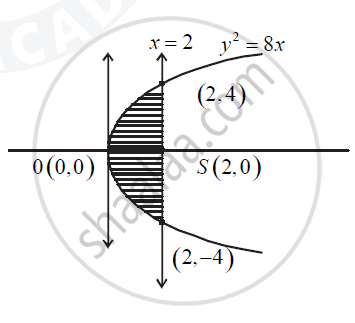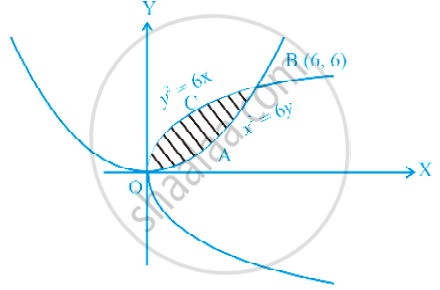Advertisements
Advertisements
प्रश्न
Draw a rough sketch of the curve and find the area of the region bounded by curve y2 = 8x and the line x =2.
उत्तर

Given equation is y2 = 8x
Comparing with y2 -4ax
we get 4a = 8
i.e a = 2
Given `y^2 = 4(2)x`
`y^2 = 8x``
`:. y = sqrt(8x)`
Also x = 2 meets `y^2 = 8x`
`:. y^2 = 16`
`:. y = +-4`
:. (2,4) and (2,-4) are their point of intersection
:. Required are `A = 2int_0^2 sqrt(8x) dx`
`=2sqrt8 int_0^2 x^("1/2") dx`
`= 4sqrt2 = [x^("3/2")/("3/2")]_0^2`
`= (8sqrt2)/3 [2^"3/2" - 0]`
`= (8sqrt2)/3 xx sqrt8`
`= (8sqrt2xx2sqrt2)/3 = 32/3` sq.units
APPEARS IN
संबंधित प्रश्न
Using integration, find the area of the region bounded by the lines y = 2 + x, y = 2 – x and x = 2.
Area bounded by the curve y = x3, the x-axis and the ordinates x = –2 and x = 1 is ______.
Find the area of ellipse `x^2/1 + y^2/4 = 1`
Using integration, find the area of the region bounded between the line x = 2 and the parabola y2 = 8x.
Sketch the graph of y = \[\sqrt{x + 1}\] in [0, 4] and determine the area of the region enclosed by the curve, the x-axis and the lines x = 0, x = 4.
Find the area under the curve y = \[\sqrt{6x + 4}\] above x-axis from x = 0 to x = 2. Draw a sketch of curve also.
Draw a rough sketch of the graph of the curve \[\frac{x^2}{4} + \frac{y^2}{9} = 1\] and evaluate the area of the region under the curve and above the x-axis.
Draw a rough sketch of the curve \[y = \frac{x}{\pi} + 2 \sin^2 x\] and find the area between the x-axis, the curve and the ordinates x = 0 and x = π.
Find the area of the region common to the parabolas 4y2 = 9x and 3x2 = 16y.
Using integration, find the area of the region bounded by the triangle ABC whose vertices A, B, C are (−1, 1), (0, 5) and (3, 2) respectively.
Find the area of the region bounded by \[y = \sqrt{x}\] and y = x.
Find the area of the region bounded by the curves y = x − 1 and (y − 1)2 = 4 (x + 1).
Using integration find the area of the region bounded by the curves \[y = \sqrt{4 - x^2}, x^2 + y^2 - 4x = 0\] and the x-axis.
The area bounded by the parabola y2 = 4ax, latusrectum and x-axis is ___________ .
The area of the region (in square units) bounded by the curve x2 = 4y, line x = 2 and x-axis is
Using the method of integration, find the area of the triangle ABC, coordinates of whose vertices area A(1, 2), B (2, 0) and C (4, 3).
Find the area bounded by the parabola y2 = 4x and the line y = 2x − 4 By using vertical strips.
Find the area of the region bounded by the parabola y2 = 2x and the straight line x – y = 4.
Find the area of the region bounded by the parabolas y2 = 6x and x2 = 6y.
Find the area enclosed by the curve y = –x2 and the straight lilne x + y + 2 = 0
Find the area bounded by the curve y = `sqrt(x)`, x = 2y + 3 in the first quadrant and x-axis.
Find the area bounded by the curve y = sinx between x = 0 and x = 2π.
Find the area bounded by the curve y = 2cosx and the x-axis from x = 0 to x = 2π
The area of the region bounded by the y-axis, y = cosx and y = sinx, 0 ≤ x ≤ `pi/2` is ______.
Using integration, find the area of the region in the first quadrant enclosed by the line x + y = 2, the parabola y2 = x and the x-axis.
Using integration, find the area of the region `{(x, y): 0 ≤ y ≤ sqrt(3)x, x^2 + y^2 ≤ 4}`
If a and c are positive real numbers and the ellipse `x^2/(4c^2) + y^2/c^2` = 1 has four distinct points in common with the circle `x^2 + y^2 = 9a^2`, then
The area bounded by `y`-axis, `y = cosx` and `y = sinx, 0 ≤ x - (<pi)/2` is
Find the area of the region bounded by curve 4x2 = y and the line y = 8x + 12, using integration.
Let T be the tangent to the ellipse E: x2 + 4y2 = 5 at the point P(1, 1). If the area of the region bounded by the tangent T, ellipse E, lines x = 1 and x = `sqrt(5)` is `sqrt(5)`α + β + γ `cos^-1(1/sqrt(5))`, then |α + β + γ| is equal to ______.
